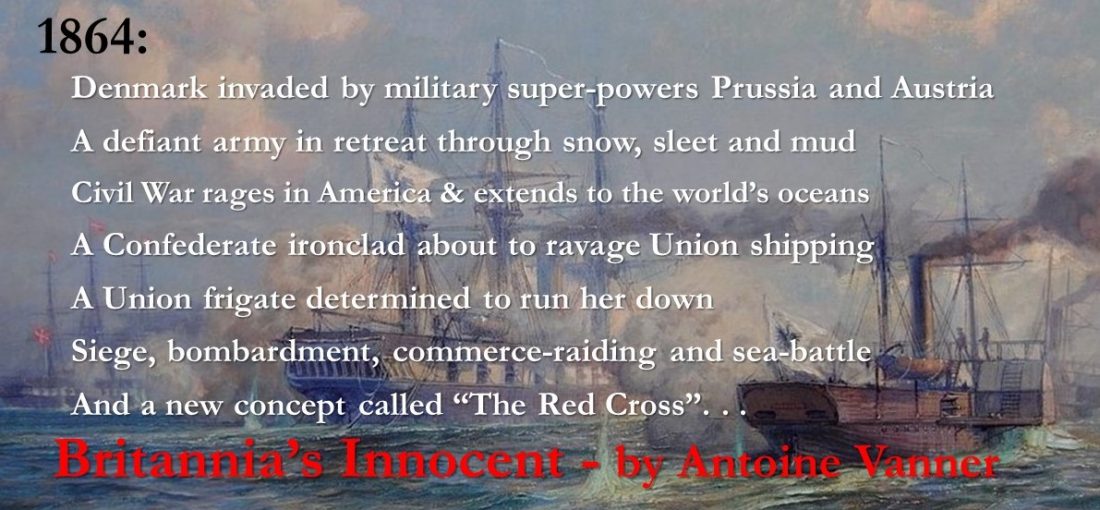HMS Quebec vs. Surveillante – 1779
Perhaps the most ferocious frigate action ever?
Single ship actions, usually between frigates, are remembered as some of the most dramatic actions of the Age of Fighting Sail. They captured the imagination of the public in their own time, making heroes of captains like Pellew and Cochrane, who gained the sort of adulation reserved for pop-stars today and they figure as central elements in the naval fiction of Forrester, Pope, Kent, O’Brian, Bond and others. Perhaps the most dramatic of all single-frigate actions occurred not during the Revolutionary or Napoleonic Wars, but when France was locked in conflict with Britain during the American War of Independence. This ferocious battle was fought by the British frigate HMS Quebec against her French counterpart Surveillante. What follows serves to give an impression of this now largely forgotten epic.
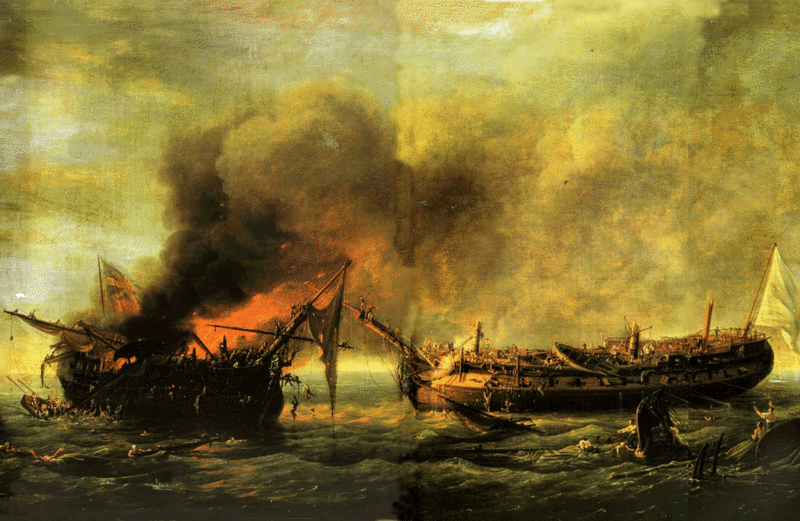
The drama of HMS Quebec vs. Surveillante action inspired many contemporary artists
– this is by the French artist Rossel de Cercy (1736-1804)
Surveillante’s‘ white ensign is that of the Royal French Navy – not a sign of surrender!
In the early summer of 1779 HMS Quebec, a small 32-gun frigate of 685 tons, armed with 12-pounders, was sent to Guernsey, as a guard for the Channel Islands, with orders to glean all the intelligence possible of French movements in and around Brest. Her captain, George Farmer (1732-1779), was well thought of in the service. Nelson had served under him as midshipman in the frigate HMS Seahorse, and Farmer thought well enough of Nelson to entrust him the duty of a watch-keeping lieutenant.
From Guernsey, Farmer sent a report on the 18th June that the French fleet had sailed from Brest, and in early July he intercepted and broke up a convoy of forty-nine French coasters, taking some and driving many of the rest ashore. In the process however HMS Quebec ran on to a rock and Farmer only got her off by throwing all his guns overboard. This necessitated a return to port to repair damage and to rearm , and HMS Quebec was lucky to reach Portsmouth in safety. On arrival however no 12-pounders were to be had and Captain Farmer had no option but to accept 9-pounders – a critical factor in the action to come – and to get to sea again as quickly as possible. By October 6th he was off Ushant, in company with an armed cutter, HMS Rambler, commanded by a Lieutenant James George, keeping a watch on Brest.
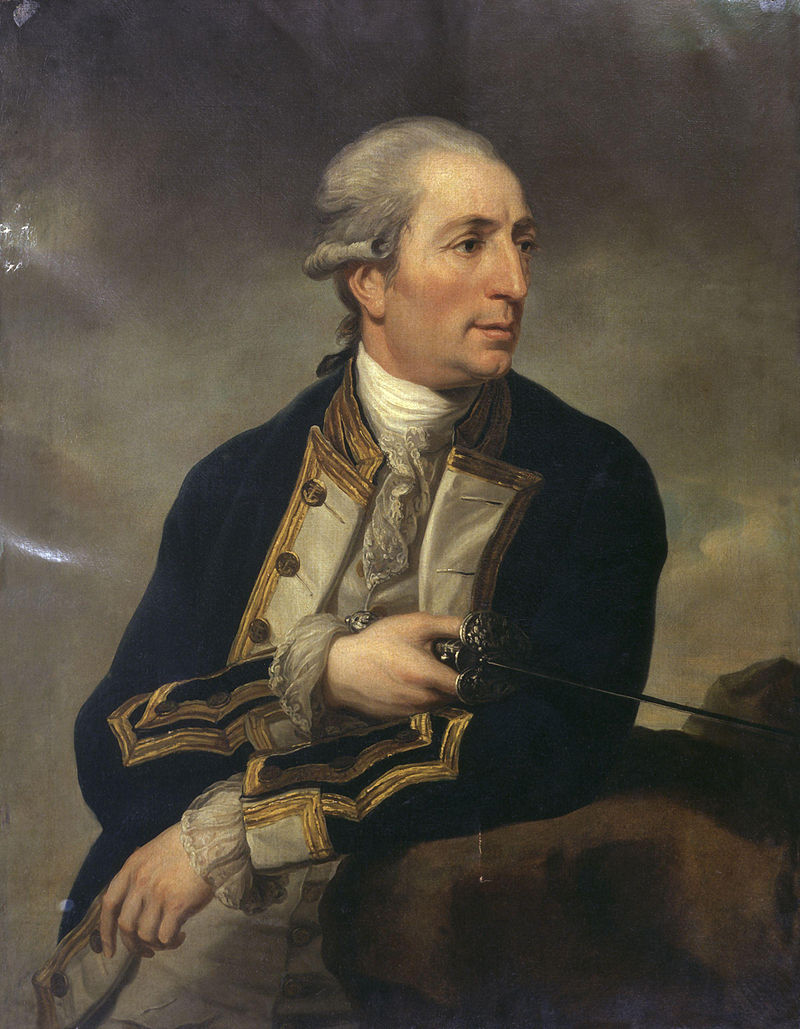
Captain George Farmer
At daybreak, HMS Quebec and HMS Rambler sighted a large French frigate and an armed cutter, and in another half hour the frigate opened fire and hastened to investigate. The French frigate proved to be the Surveillante, commanded by the able Lieutenant Du Couëdic. She was a considerably larger and more powerful vessel than the under-gunned HMS Quebec, carrying 34 guns, apparently a mix of 12 and 18-pounders. Due to the substitution of HMS Quebec’s of 9-pounders for her previous 12-pounders the French ship was by at least thirty percent the more powerful fighting machine of the two, She had a crew of 255 men as against the Quebec‘s 195.
The action opened in mid-morning and was fought in a heavy swell, though little wind. Du Couëdic kept his ship close-hauled on the port tack, while Farmer, sailing free on the same tack, edged down towards him. At ten o’clock, or a few minutes after, HMS Quebec hoisted her colours, hauled her wind, and began to return the enemy’s fire at short range. In the cannonading that followed, lasting a full hour, neither side had the best of it. Then the Surveillante drew ahead and Farmer, quickly backing his topsails, put his helm up and tried to go under her stern and rake her. Du Couëdic bore up simultaneously to frustrate the manoeuvre and both ships were before the wind, masts tottering and sails in tatters.
Both vessels were taking heavy losses. Some of HMS Quebec‘s guns-crews were reduced from seven men to three. Farmer had sustained a broken collarbone and a smashed finger but he remained on deck to encourage his dwindling crew. The first lieutenant had his arm shot away but when the surgeon had done with him he returned to the quarterdeck. Twice the fire of the Surveillante ceased, and HMS Quebec’s crew cheered, thinking they had her beaten – but each time, after a brief interval, the French reopened fire with increased vigour.
The gunnery duel continued until about one o’cIock when the Surveillante‘s masts went overboard together. They fell in the most fortunate manner for her, on the disengaged port side, and her fire remained unimpeded. Five minutes, before Farmer could take advantage of his enemy’s plight, HMS Quebec’s masts followed suit, the fore and mainmast falling inboard, blocking the gangways, and putting the guns on the forecastle and quarter-deck out of action. Worst of all the mizzen-mast fell outward on the engaged side, and the mizzen-topsail completely covered over the port-holes of several of the broadside weapons forward the stern.
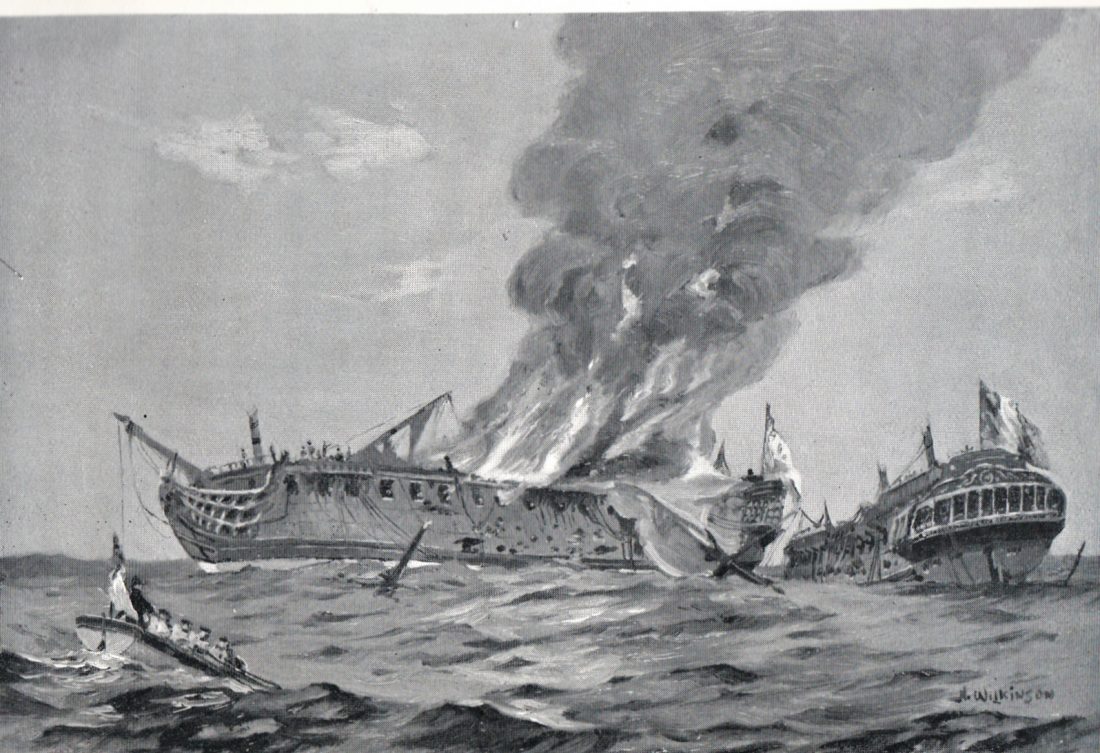
Victorian- period illustration of the action – note the anachronistic error in that the French ensign is shown as a tricolour – which would not be introduced until the Revolutionary era, still in the future in 1779
Neither vessel was under control now and as they drifted they locked together, Surveillante‘s bowsprit becoming entangled in the wreckage of masts and sails which encumbered HMS Quebec’s decks amidships. Du Couëdic called for boarders, but when preparing to launch an assault was struck down by a musket ball –the third wound he had received during the action. His officers, though momentarily shaken by his injury, were rallying the boarding-party, when the issue was taken out of their hands.
HMS Quebec’s mizzen-topsail, which had been masking the stern guns on the port-side, since the mast had fallen, now caught fire. The guns crews continued to blaze away through the tattered canvas hanging a few feet from the muzzles. The flames ran up the sail, took fierce hold on the wreckage on the quarter-deck, and in an instant were roaring over the after part of the ship. The French, abandoning all thoughts of boarding, used every effort to get clear, fending HMS Quebec off with spars and booms. They were only just in time, for the stump of their bowsprit was a mass of flame, only quenched with difficulty as the two ships were disentangled.
The engagement was over, and HMS Quebec was doomed. du Couëdic, wounded, gave orders that when the flames in his own ship had been extinguished firing should cease and HMS Quebec’s crew rescued – many had already jumped overboard to escape the flames. All Surveillante’s boats were too damaged to float however and nothing could be done but to throw ropes to any survivors who could swim alongside.
In HMS Quebec Captain Farmer gave orders to flood the magazine, and took what measures he could to fight the fire. This proved hopeless but Farmer refused to leave his ship. In mid-afternoon the magazine exploded. The hull burnt fiercely for a considerable time before it sank. Though accounts of the exact manner of Farmer’s death differ there is no doubt that he went down with his ship, her flag still flying.

Painting by British painter Richard Dodd shows the Surveillante (L) keeping as far away as possible from the doomed HMS Quebec as an explosion was clearly imminent. The cutter on the far right is probably the French cutter Expedition. In the foreground note Rambler’s boat rescuing survivors from Quebec.
While the two frigates were locked in combat a separate action was underway between HMS Rambler and the French cutter Expedition, which had been in company with the Surveillante. These smaller vessels were fairly matched for each other and until the Quebec caught fire neither had much advantage. The sight of HMS Quebec in flames, and of the Surveillante locked to her of her, induced the Expedition to make off to the help of her frigate. HMS Rambler’s commander, Lieutenant George not unnaturally claimed that the Expedition made off because she was getting the worst of it. In his late report he stated that owing to the damaged state of his rigging he was unable to pursue; then, “seeing both the frigates dismasted and the Quebec on fire I endeavoured to get as near the Quebec as possible in hopes of saving some of her men, but there being but little wind and a large swell, found I could assist her in no other way but by hoisting out our boat, which I effected, and sent the master and five men armed in her, who picked up one master’s mate, two young midshipmen, and fourteen more of the Quebec’s people, the enemy’s frigate at the same time firing at the boat.”
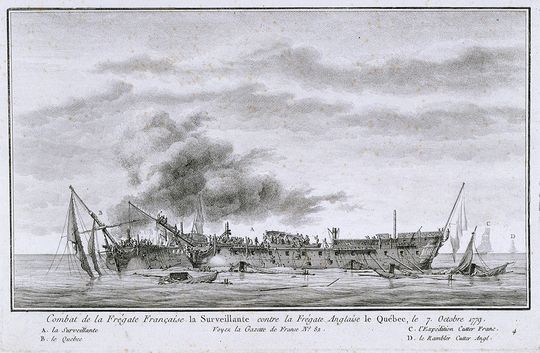
A French view of the action – almost photographic in detail
The Surveillante saved some of HMS Quebec‘s crew, HMS Rambler a few more and 13 were picked off afterwards a mass of floating wreckage by a Russian ship that was in the vicinity, and landed at Salcombe, in Devon. Another 14 were spotted on other flotsam but as the Russian altered course to pick them up a heavy squall came on, and when it lifted they were gone. Out of HMS Quebec’s company of 195 only 68 were saved.
The Surveillante lost 115 killed and wounded out of 211 – a 50% casualty rate and she was towed to Brest harbour by the Expedition in a sinking condition. du Couëdic, was promoted immediately but died a few months late as a result of his wounds.
The French behaved with notable chivalry to HMS Quebec‘s survivors picked up by the Surveillante. They were sent back free to England on the grounds that the French Minister of Marine “did not think it right to consider as prisoners of war unfortunate men who had escaped the fight, the fire which blew up their ship, and the watery gulf into which they had been hurled.” It was particularly touching that Du Couëdic, of the Surveillant, despite his own ultimately mortal wounds, took pains to see that they were made as comfortable as possible.
The surviving officers of HMS Quebec were tried by court-martial at Sheerness, and the court found that “everything possible was done to save the ship, and that Captain Farmer, her officers and men, behaved in the most spirited and gallant manner, and are of opinion that if the accident of fire had not happened they would have taken the French man-of-war
Farmer’s eldest son was made a baronet, a pension of £200 per annum was granted to his widow and pensions of £25 each to nine of his children, including one yet unborn. A Board-of-Admiralty Minute records that these honours were paid in order “to excite an emulation in other officers to distinguish themselves in the same manner, and render Captain Farmer’s fate rather to be envied than pitied, as it would give them reason to hope that if they should lose their lives with the same degree of stubborn gallantry, it would appear to posterity that their services had met with the approbation of their Sovereign.”
The accounts I have seen of this action make no reference to the compensation or pensions paid to other members of HMS Quebec’s crew. Nothing could have been too much for the men who endured the hours of hell this ferocious battle lasted and one only hopes that the widows, orphans and dependents received some recompense, however small.
Start the 11-volume (so far!) Dawlish Chronicles series of novels with the earliest chronologically:
Britannia’s Innocent
 1864 – Political folly has brought war upon Denmark. Lacking allies, the country is invaded by the forces of military superpowers Prussia and Austria. Across the Atlantic, civil war rages. It is fought not only on American soil but also on the world’s oceans, as Confederate commerce raiders ravage Union merchant shipping as far away as the East Indies. And now a new raider, a powerful modern ironclad, is nearing completion in a British shipyard. But funds are lacking to pay for her armament and the Union government is pressing Britain to prevent her sailing. The Confederacy is willing to lease the new raider to Denmark for two months if she can be armed as payment, although the Union government is determined to see her sunk . . .
1864 – Political folly has brought war upon Denmark. Lacking allies, the country is invaded by the forces of military superpowers Prussia and Austria. Across the Atlantic, civil war rages. It is fought not only on American soil but also on the world’s oceans, as Confederate commerce raiders ravage Union merchant shipping as far away as the East Indies. And now a new raider, a powerful modern ironclad, is nearing completion in a British shipyard. But funds are lacking to pay for her armament and the Union government is pressing Britain to prevent her sailing. The Confederacy is willing to lease the new raider to Denmark for two months if she can be armed as payment, although the Union government is determined to see her sunk . . .
Just returned from Royal Navy service in the West Indies, the young Nicholas Dawlish volunteers to support Denmark. He is plunged into the horrors of a siege, shore-bombardment, raiding and battle in the cold North Sea – not to mention divided loyalties . . .
For more details, click below:
For amazon.com For amazon.co.uk For amazon.com.au
The Dawlish Chronicles – now up to eleven volumes, and counting. In Kindle and paperback. Kindle Unlimited subscribers read at no extra charge. Click on image for details of each.
Six free short-stories are available for download to your Kindle. Access them by registering for the Dawlish Chronicles mailing list – just click on the banner below. You’ll be kept updated on new books and will receive other free stories at intervals.

